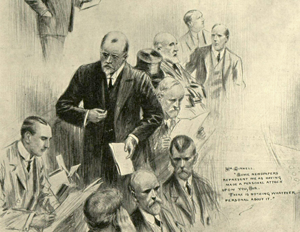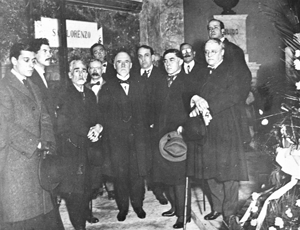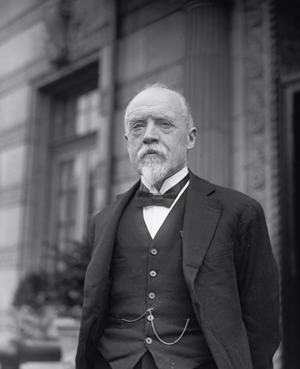LAURENCE GINNELL (1852–1923), ONE OF THE TRULY GLOBAL FIGURES OF THE IRISH REVOLUTION
Published in Features, Issue 3 (May/June 2023), Volume 31By Paul Hughes

Above: Laurence Ginnell in conflict with the Speaker of the House of Commons, James Lowther, as sketched for the Illustrated London News in February 1911. (British Newspaper Archive)
From the meadows of the midlands to the corridors of Westminster, and from the gridded streets of Chicago to the Argentine pampas, few prominent figures of the Irish revolution enjoyed a reputation as in equal parts local, national and global as Laurence Ginnell, who died 100 years ago in April 1923.
Born in the scarred post-Famine landscape of Delvin, Co. Westmeath, in 1852, Ginnell went on to serve for over eleven years as MP for North Westmeath (1906–17). An exception to the old adage that conservatism comes with age, at 65 he turned his back on Westminster to become a revolutionary. Remarkably for a man whose political career began as a functionary in the Parnell-era Irish National League (1885), Ginnell ended life among the most zealous of anti-Treaty republicans.
Later a member of the Dáil, Ginnell holds the peculiar record of being the only elected representative forcibly ejected from both British and Irish parliaments. An innovative neo-obstructionist, he had a talent for disrupting parliamentary procedure and was capable of spinning any personal consequences suffered for his agitation into the story of an ordinary man being crushed under the weight of an institution. He had an aptitude for propaganda and press relations, forged in the Irish Press Agency in London during the 1880s and further developed during his time as private secretary to John Dillon.
CATTLE-DRIVING AND THE ‘RANCH WAR’
Although having garnered during the 1890s a modest international reputation in the niche area of legal history—penning, among other things, an authoritative study of Brehon law—what first catapulted Ginnell to fame was his prosecution of the 1906–9 ‘ranch war’ in the midlands and west. He was described by the London Times on his death as the ‘inventor’ of political cattle-driving, a strategy observed with fascination from as far away as the United States, where cattle-driving was primarily a romanticised form of Gilded Age economic activity. So synonymous was Ginnell with the agrarian question that, when he arrived in the United States on Dáil business in July 1920, the Boston Globe mistitled him ‘Minister for Agriculture in the Irish republican government’.
Tim Healy later opined that if the cattle-driving tactic had been employed during the Land War it would have accelerated land reform in Ireland. By 1908, however, when Ginnell was briefly imprisoned for inciting the practice, many of these reforms had taken place. John Redmond’s Irish Parliamentary Party (IPP), which initially embraced the ‘ranch war’, abandoned the campaign, not least because it had exposed the party hierarchy’s intimate connections to the ranching interest so vehemently opposed by Ginnell. When the outspoken MP claimed that the party had turned a blind eye to corruption in the United Irish League, its vehicle for agrarian activism, he was sidelined as a ‘factionist’ and marked for political destruction. De-selected ahead of the January 1910 general election, Ginnell nevertheless survived after an improvised campaign, returning to the House of Commons as an independent nationalist.
WILDERNESS
Victories in the 1910 general elections liberated Ginnell from the yoke of the party whip, but the IPP’s new status as kingmakers for Herbert Asquith’s Liberal government, which placed Home Rule back on the table, left him in the political wilderness. In the ensuing years he developed new strategies to remain in the public eye. Propaganda, as opposed to agrarianism, became central to his political being, earning him an international reputation as the voice of the Irish nationalist ‘other’ in Westminster.
No sooner had Ginnell returned to parliament on 30 January 1911 than he set about recasting himself in this mould. As parliament moved to elect James Lowther as Speaker of the House, Ginnell ingeniously seized on a sede vacante moment to rail against what he perceived as Lowther’s partiality as Speaker. Ginnell’s stance earned sympathy from some Labour and Liberal (Radical) MPs, as well as political commentators like Hilaire Belloc, who at the time had just published The party system, a polemic against political oligarchy in Westminster. The net effect was that in subsequent years Lowther gave Ginnell much more latitude in contributing to debates. This allowed him to frequently speak his mind on topics as diverse as Home Rule and women’s suffrage and to air separatist propaganda about the theft of the Irish crown jewels. It was the outbreak of the First World War, however, that put Ginnell firmly in the spotlight.
ENGLAND’S DIFFICULTY IS GINNELL’S OPPORTUNITY

Above: Laurence Ginnell (centre) on 5 August 1921 at the cathedral in Buenos Aires, where he participated in a wreathlaying ceremony at the tomb of the Argentine national hero, General José de San Martín. (Yanina Bevilacqua, Irish Embassy, Buenos Aires)
From January 1915, Ginnell was persistent in his parliamentary attacks on what he viewed as the financial and oligarchical wirepullers driving the European war and, by extension, the government war policy to which the project of Irish Home Rule was now wedded. Between 1914 and his eventual departure from Westminster two years later, he made nearly 3,000 contributions in parliament, nearly double the combined input of what Conor Mulvagh has termed the IPP ‘tetrarchy’ of Redmond, Dillon, T.P. O’Connor and Joseph Devlin. With Ginnell’s barrages of supplementary questions making colourful copy for the foreign press, the impact of his rhetoric was instant and widespread. Patrick Egan, a leading Redmondite in America who had served as the US ambassador to Chile, asked Redmond’s private secretary in March 1915: ‘Cannot the Westmeath men be got to choke off the braying of this ass?’
Keenly aware of the developing ‘world crisis’, Ginnell insisted on the neutrality of Ireland, a claim that bemused British ministers. He also took an active interest in other emerging nationalities, grilling the Asquith cabinet on Indian, Ceylonese and Egyptian affairs and on the welfare of their expatriates. In December 1915 he was fêted at London’s Imperial Hotel by Egyptian nationals, who presented him with an Arabic poem in recognition of his advocacy on their behalf. By engaging with anti-imperialist sentiment in Africa and Asia while conceptualising Ireland’s place in the world, Ginnell was sketching out a framework for an independent Irish foreign policy long before the Department of Foreign Affairs came into existence.
‘THE MEMBER FOR IRELAND’
By now christened ‘the Member for Ireland’, Ginnell was ideally placed to shape the changing narrative in the wake of the Easter Rising. His parliamentary questioning intensified and he visited Irish internees in prisons across the country, while his wife Alice—a prominent campaigner in her own right—worked closely alongside Art O’Brien to organise a relief campaign in London. With Britain eager to involve the United States in the ongoing war against Germany, high-ranking government officials were concerned at the impact that Ginnell’s parliamentary interrogations about conditions in Ireland, as well as prisoner welfare, was having on opinion at home and abroad. Evidence of these concerns can be found, for example, in a May 1916 letter from Herbert Samuel, the British Home Secretary, to King George V. Meanwhile, American newspapers took an increasing interest in Ginnell’s statements, with Fr Peter Yorke’s San Francisco Leader identifying him as the second most powerful man in Ireland.
Although Ginnell was at the apogee of his power in Ireland at this time, far from indulging a ‘man of destiny’ complex, he did what he could from 1916 through 1917 to contribute to building a new political consensus in Ireland. He played a key role in pushing the separatist case in the various by-election campaigns of 1917 before leaving parliament to join the newly reconstituted Sinn Féin in the autumn. Meanwhile, as the Irish Republican Brotherhood (IRB) sought to establish relations with the revolutionary Russian provisional government in Petrograd, Ginnell—who was not a member of the IRB—was sought out by the Russians to act as the conduit for future correspondence. This arrangement, however, did not survive the Bolshevik revolution later in the year.
At home, Ginnell sought to infuse Sinn Féin with a radical agrarian tendency, and toured his old stamping-grounds in the midlands and west urging landless men to drive cattle and seize land. The British authorities, perhaps fearing social revolution in Britain and Ireland more than it did Irish separatism, moved quickly to remove him from the public eye, and he spent much of 1918–20 in various jails. While incarcerated, he wrote letters to US president Woodrow Wilson, authored a justification of Ireland’s historic claim to independence (later published) and fought the December 1918 election campaign. One of 73 Sinn Féin MPs who pursued a policy of abstention and established the First Dáil, Ginnell was appointed the revolutionary government’s director of propaganda in April 1919. Before long, however, he was back in prison, with each return to a cell taking a heavy toll on his health.
‘CO-ADJUTOR’
This cycle of imprisonment and recovery was broken in the summer of 1920, when Ginnell was despatched to Chicago in a Dáil consular role. On arrival, he was heralded by the American press as the ‘co-adjutor’ of the Sinn Féin leader Eamon de Valera, who was on a tour of the country at the time. According to Alice Ginnell, her husband had been summoned to the US by de Valera as an ally whose experience in political faction-fighting would help him to negotiate the thorny landscape of Irish-American politics.
In Chicago Ginnell encountered a fellow Westmeath native, the trade unionist John Fitzpatrick, and sought to forge ties between the republicans, labour activists and ethnic minorities. In the autumn of 1920 he sat in on an Irish-American delegation that met with US Secretary of State Bainbridge Colby in a vain effort to secure some official expression of sympathy for Terence MacSwiney after his death on hunger strike. Some months later, he delivered a lengthy testimony before the American Commission on Conditions in Ireland, in which he spoke about, among other things, plans to order an independent Irish economy along co-operative lines.
Ultimately, Ginnell had to be reassigned when he set up an Irish relief fund in Chicago which threatened to undermine the fund-raising efforts of de Valera’s new American Association for the Recognition of an Irish Republic (AARIR). He was initially sent on a speaking tour of the southern states of Arizona, New Mexico and Texas, where he encountered audiences possessed by strongly nativist, anti-Catholic and anti-Irish sentiments.
ARGENTINA
Astutely, Harry Boland advised de Valera that Argentina was ultimately the best destination for Ginnell, given the strong Longford/Westmeath connections among the Irish community there and the need for a consolidation of Dáil interests in South America. The Ginnells set sail for Buenos Aires in July 1921 with the intent to raise a loan among the Irish community, but their plans were immediately undermined by the truce between the Crown and the IRA.
Ginnell enjoyed a series of propaganda jousts with the British minister in Buenos Aires, Ronald Macleay, was treated to semi-official lionisation and managed to secure an unofficial meeting with the Argentine foreign minister, Honorio Puerreydón. As Michael Kennedy and Dermot Keogh have amply explained, however, fund-raising was a difficult sell for the irlandéses amid ongoing peace talks, and was scuppered completely by the signing of the Anglo-Irish Treaty. And there was more than a hint of irony in the fact that many of those Irish from whom the radical agrarian Ginnell sought financial support were affluent estancieros, or ranch farmers.
ISOLATED
Ginnell’s decision to oppose the Treaty left him isolated among the Irish-Argentine community, the majority of whom accepted the agreement as a natural end to the independence struggle. He was recalled to Ireland, and in the build-up to the Civil War he became an active propagandist against the Provisional Government set up under the terms of the treaty. The culmination of this was his appearance, on 9 September 1922, at a sitting of the ‘provisional parliament’ (the third Dáil according to pro-Treaty tradition), resulting in his ejection. The incident naturally garnered him more international attention, and his ejection was captured on British newsreels.
In November Ginnell was named by Eamon de Valera as the anti-Treatyites’ chief envoy to the United States. Although he was clothed in sweeping powers, his return to America served only to antagonise the bloated array of republican activists already working there. He led a very public but ultimately unsuccessful effort to wrest control of the Irish consulate in New York from Irish Free State representatives. Crucially, he failed to gain access to the large quantity of funds raised by Sinn Féin in America since 1919, effectively rendering his mission null and void.
Falling back on his old propaganda beat, Ginnell published a republican legation circular out of his office at Washington’s Hotel Lafayette, and committed a series of faux pas which fatally undermined his standing among his republican colleagues. J.J. O’Kelly (‘Sceilg’), arguably the leading republican in the US before Ginnell’s arrival, disliked how close his new chief had become to progressive figures at the head of the AARIR, like the organisation’s national president, John F. Finerty. O’Kelly, the Catholic moralist, regarded Finerty and others as ‘pagans’ and opportunists shilling for partisan American political interests.
DEATH
It was, however, Ginnell’s attempts to interfere with the operation of ongoing republican fund-raising campaigns that led to an eventual break with O’Kelly and other leading anti-Treaty campaigners like Joseph O’Doherty and Hanna Sheehy Skeffington. In the midst of these fallings-out, and days after de Valera all but pulled the plug on his mission, Ginnell died suddenly of heart failure at his Washington hotel on 17 April 1923.
In a widely syndicated obituary, Ginnell’s former IPP colleague T.P. O’Connor called him the Jean-Paul Marat of the Irish revolution—a figure who ‘seemed little better than a madman to the House of Commons’ and whose intensity of belief in his cause seemed to ail him physically and mentally. The Gaelic American claimed that Ginnell was once overheard complaining to an American listener that blowing up the British embassy in Washington would be a far more fruitful exercise than persisting with efforts to drum up support in the US. Nevertheless, even these detractors, as well as his many proponents, agreed that Ginnell was endowed with a well of cleverness, sincerity and intellectual prowess. A key figure in what Roy Foster has termed the ‘pre-revolution’, he harnessed an already established international reputation and channelled it into working out new ways to project a nascent Irish state onto the world stage.
As a parliamentarian, and later in the spheres of republican propaganda, diplomacy and political organisation, Ginnell was one of the truly global figures of the Irish revolution.
Paul Hughes is a graduate of Maynooth University and Queen’s University, Belfast, currently writing a biography of Laurence Ginnell.
Further reading
F.M. Carroll, American opinion and the Irish Question, 1910–23 (Dublin, 1978).
D. Keogh, Ireland and Argentina in the twentieth century: diaspora, diplomacy, dictatorship, Catholic mission and the Falklands crisis (Cork, 2022).
M. Laffan, The resurrection of Ireland: the Sinn Féin party, 1916–1923 (2nd edn) (Cambridge, 2005).
M. Wheatley, Nationalism and the Irish Party: provincial Ireland, 1910–1916 (Oxford, 2005).

















